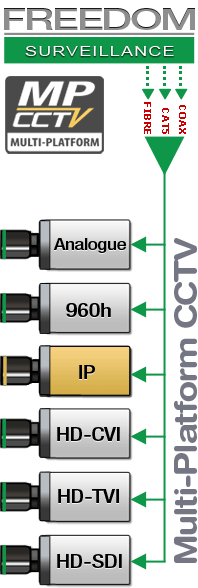What is Onvif video surveillance?
ONVIF™ (Open Network Video Interface Forum) is an open standard developed to allow the management of IP cameras and other network video devices via a unified, open platform standard. ONVIF is an organization started in 2008 by Axis Communications, Bosch Security and Sony. The aim of the ONVIF™ standards is to achieve interoperability between IP cameras and other network video devices regardless of manufacturer.
The cornerstones of Onvif
- Standardization of communication between network video devices
- Interoperability between network video products regardless of manufacturer
- Open to all companies and organizations
Benefits of Onvif
The primary benefit of the ONVIF standard is the freedom to choose hardware from any manufacturer that is 'ONVIF compliant'. With Onvif you are no longer tied to a proprietary solution. The ONVIF platform shares most of the benefits that traditional proprietary IP cameras share. As Onvif devices become more main-stream VMS providers can spend less time integrating new proprietary drivers and more time developing new features. All Sony 5th generation products are Onvif compliant and as of early 2010 most Samsung IP cameras will be Onvif compliant.
Remote Camera Configuration
The ability to remotely configure an ONVIF camera will both reduce your total cost of ownership and camera system down time.
Remote ⁄ off-site access
ONVIF cameras can be configured to be accessible over WAN environments, utilizing the low bandwidth sub-stream of the ONVIF camera.
Drawbacks of Onvif
Onvif is a new standard and as such has issues. From our experience there are 2 combining factors contribute to the reliability of an Onvif based CCTV system and they are.
- How good a camera manufactures implementation of the Onvif protocol is.
- How well VMS manufacturer ensure the quality of the marriage between their implementation of Onvif protocol and each camera manfacturers.
Some IP camera features and enhancements may not be available when using a VMS that exclusively supports the ONVIF standard. To take advantage of some of these features you may need to use the manufacturers own proprietary VMS (Video Management System) application or choose a VMS that supports these enhancements.
Network Integration / Scalability
If you have an existing computer network infrastructure, which most organizations now do, an ONVIF based CCTV system can be integrated into their network. This often eliminates the need to run extra cables, because cameras can be plugged into a free Ethernet port/panel. This can significantly reduce installation costs when you need to add another camera. You must purchase equipment that is ONVIF compliant.
Transitional Upgrading
Upgrading to an ONVIF based CCTV system can be done in stages. Analogue cameras can be integrated into an ONVIF™ CCTV systems via the use of an ONVIF compliant encoder, or you could start replacing your analogue cameras with ONVIF compliant cameras that have analogue outputs, then at a later stage you could replace your DVR with an NVR. Adding an ONVIF camera is like adding an additional computer, just plug it into an existing free LAN port.

